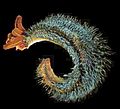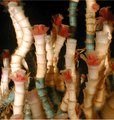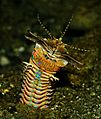Polychaete facts for kids
Quick facts for kids Polychaetes |
|
|---|---|
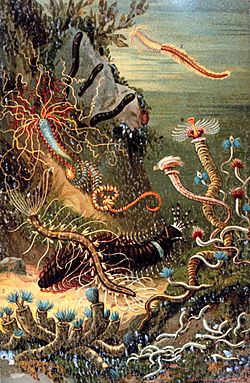 |
|
| A variety of marine worms from Das Meer, M.J. Schleiden (1804–1881). |
|
| Scientific classification | |
| Kingdom: | |
| Phylum: | |
| Class: |
Polychaeta
Grube, 1850
|
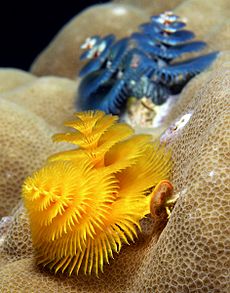
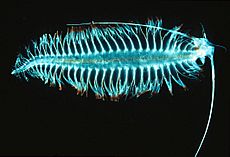
Polychaetes, also known as bristle worms, are a special group of annelid worms. They mostly live in the ocean. There are over 10,000 different kinds, or species, of polychaetes.
These worms are very old animals. Scientists have found their fossils from about 518 million years ago. The oldest ones were found in Greenland.
Each part of their body has small, fleshy parts that stick out. These are called 'parapodia'. They have many bristles made of a tough material called chitin. This is how they are different from other similar worms, like earthworms, which have only a few bristles.
Some common bristle worms you might hear about are the lugworm and the clam worm. The clam worm is also sometimes called a 'sandworm'.
Contents
What are Polychaetes Like?
Polychaetes are worms with bodies made of many segments. Most are less than 10 centimetres (3.9 in) long. But some can be tiny, only 1 millimetre (0.039 in), while others can grow very long, up to 3 metres (9.8 ft)!
Many of these worms are very colorful. They can even be shimmering or glow in the dark.
How They Move and Breathe
Each body segment has a pair of paddle-like 'parapodia'. These help the worm move around. Many species use their parapodia to breathe. The parapodia have lots of blood vessels, which help them take in oxygen from the water.
Some bristle worms have bristles that can sting. If a predator tries to grab them, the bristles can break off. This can cause a painful sting.
Their Heads and Senses
Polychaetes have a well-developed head, called a prostomium. It sits over their mouth, which is on the underside of their body. Most have two to four pairs of eyes. Some species are blind. Their eyes are usually simple, helping them tell light from dark. But some have big eyes with lenses, which might help them see clearly.
Their heads also have a pair of antennae and tentacle-like 'palps'. They also have special pits called "nuchal organs". These organs help the worm smell and find food.
Where Polychaetes Live
Polychaetes have many different ways of living. Most of them burrow into the sand or mud. Some build tubes to live in. Others swim freely in the water, like tiny creatures in the plankton. A few even live with other animals without harming them. Some are parasites.
Worms that move a lot often have good senses and strong jaws. Worms that stay in one place might not have these. Instead, they might have special gills or tentacles. These help them breathe and catch food from the water.
A few types of polychaetes can live on land. But they need very wet places to survive. Some have even developed special tubes inside their skin. These tubes work like simple lungs, helping them breathe air.
Amazing Polychaete Species
- The Pompeii worm (Alvinella pompejana) lives near hot hydrothermal vents in the Pacific Ocean. These worms can handle very high temperatures, up to 80 °C (176 °F)!
- A newly found group, Osedax, includes a species called the "bone-eating snot flower". It eats the bones of dead whales.
- Another interesting polychaete is Hesiocaeca methanicola. It lives on frozen methane ice deep in the ocean.
- Lamellibrachia luymesi is a very long tube worm. It can grow over 3 meters (10 feet) long. It might be the longest-living animal, living for more than 250 years!
- Scientists saw a new type of predatory polychaete worm in the Mariana Trench. This is the deepest part of the ocean. The worm was about an inch long, but they couldn't catch it to study it closely.
What Bristle Worms Eat
Most bristle worms are scavengers. This means they eat dead plants or animals. But some are good predators. They hunt and eat fishes or even coral. Others prefer to eat algae.
You can often find them hiding in reefs or rocky areas. They crawl along the seafloor or the bottom of tide pools. They are always looking for something to eat.
Images for kids
-
Hesiocaeca methanicola lives at great depths on methane ice
-
The cold seep tube worm Lamellibrachia can live over 250 years
-
The predatory Bobbit worm
-
Giant tube worms can tolerate extremely high hydrogen sulfide levels
See also
 In Spanish: Poliquetos para niños
In Spanish: Poliquetos para niños




